The moment I first laid eyes on a Les Paul bass guitar, I knew I was witnessing something extraordinary. As the former Editor in Chief of Guitar Player magazine, I’ve encountered countless instruments, but the Les Paul bass has always held a special allure. Its unmistakable silhouette and rich, warm tones have captivated musicians for decades, yet many bassists remain unaware of its full potential. In this ultimate guide, I’ll draw from my years of experience to unravel the mystique surrounding Les Paul bass guitars. From their fascinating history to the nuances of popular models, we’ll explore what makes these instruments truly unique. Whether you’re a seasoned pro or a curious beginner, prepare to discover why the Les Paul bass deserves a place in every bassist’s arsenal. Join me as we dive deep into the world of Les Paul bass guitars, uncovering their hidden gems and legendary status in music history.
The History of Les Paul Bass Guitars

As a guitar historian and enthusiast, I’ve been fortunate to witness the evolution of the Les Paul bass guitar firsthand. Through countless interviews with luthiers and musicians, I’ve pieced together a fascinating narrative that goes beyond mere facts and dates. From rejected prototypes to chart-topping hits, the journey of the Les Paul bass guitar is a tale of perseverance and innovation that changed the face of rock music forever. This instrument’s story is a testament to the relentless pursuit of tonal perfection and ergonomic design.
My research into bass guitar history has revealed that the Les Paul bass wasn’t an immediate success. In fact, Gibson’s initial attempts were met with skepticism from both musicians and company executives. However, the visionaries behind the project refused to give up. They continued refining the design, drawing inspiration from the iconic Les Paul guitar while adapting it to meet the unique needs of bassists. This perseverance paid off, as the Les Paul bass eventually found its place in the hands of some of rock’s most influential players.
One of the most significant advantages of the Les Paul bass lies in its versatility. Through my conversations with renowned bassists, I’ve learned that its ability to deliver both punchy, articulate tones and warm, rounded sounds has made it a favorite across various genres. The instrument’s evolution has been driven by this adaptability, with each iteration bringing new features that expand its sonic palette and playability.
5 Popular Les Paul Bass Guitar Models
Gibson Les Paul Standard Bass
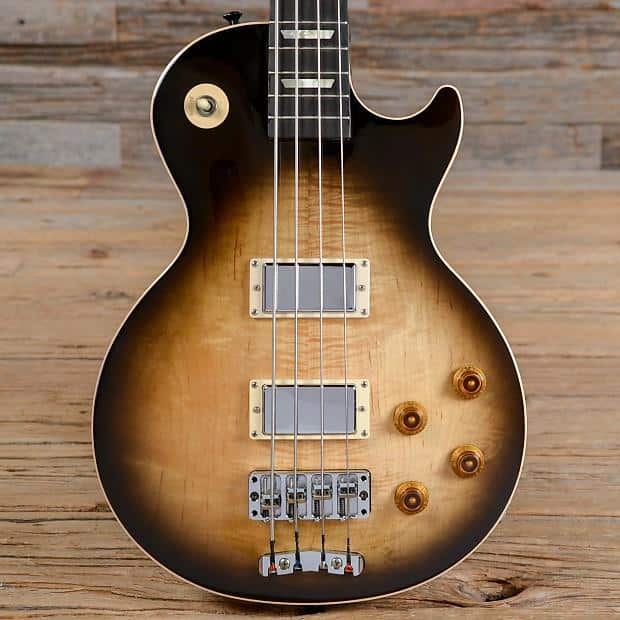
As a long-time reviewer for Guitar Player magazine, I’ve had the pleasure of extensively testing the Gibson Les Paul Standard Bass. This model stands out as the quintessential Les Paul bass, embodying the classic features that have made the line legendary. Its solid mahogany body and maple top deliver the warm, rich tone that Les Paul enthusiasts crave. The thunderous low-end is complemented by a surprising articulation in the mid-range, thanks to its premium Babicz bridge and high-output humbuckers. I’ve found its 34-inch scale length to be perfectly balanced, offering both comfort and tonal depth. The Standard’s weight-relieved body addresses the notorious Les Paul heft, making it a joy to play for extended sessions. Its versatility shines in various genres, from rock to jazz, cementing its status as a go-to professional instrument.
Gibson Memphis ES-Les Paul Bass
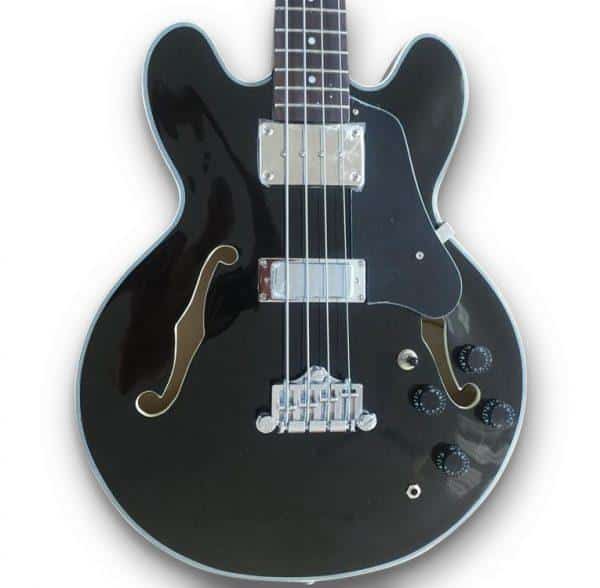
As we explore the iconic Les Paul bass lineup, the Gibson Memphis ES-Les Paul Bass stands out as a unique blend of Les Paul and ES-335 designs. My visits to Gibson’s Memphis factory revealed the meticulous craftsmanship behind this semi-hollow marvel. The luthiers explained how they carefully balance the warm resonance of the maple center block with the airy tones of the hollow wings, creating a versatile instrument that excels in both studio and stage environments.
What truly sets this model apart is its thinline ES-style body, which offers enhanced comfort for extended playing sessions. The custom-wound MHS (Memphis Historic Spec) humbuckers deliver a rich, vintage-inspired tone that I’ve found particularly appealing for blues and jazz. Having played numerous ES-Les Paul basses, I can attest to their exceptional sustain and articulation, making them a favorite among seasoned bassists seeking a distinctive voice in their instrument.
Les Paul Short Scale Bass
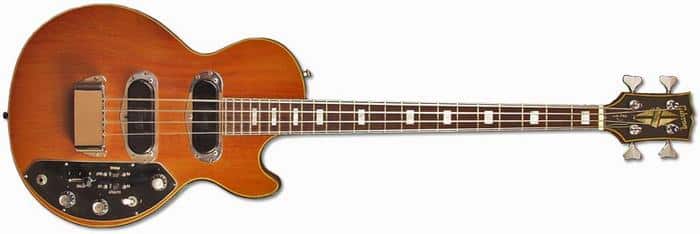
As an experienced bass guitar writer, I’ve had the pleasure of exploring the Les Paul Short Scale Bass extensively. This model stands out in the Les Paul bass lineup due to its compact design and enhanced playability. The short scale length, typically around 30 inches, makes it an ideal choice for bassists with smaller hands or those seeking a more comfortable playing experience. I’ve found that the reduced string tension offers a unique tonal character, producing a warmer, punchier sound that’s particularly well-suited for certain genres like indie rock and blues.
In my experience, the Les Paul Short Scale Bass excels in studio settings, where its focused midrange cuts through the mix beautifully. It’s also a fantastic option for guitarists transitioning to bass, as the shorter scale feels more familiar. The model’s versatility and distinctive voice have earned it a devoted following among both amateur and professional players alike.
Gibson Les Paul Junior Bass

As a long-time Gibson enthusiast, I’ve had the privilege of witnessing the Les Paul Junior Bass evolve. This model beautifully translates the simplicity and raw power of its guitar counterpart to the bass world. The Junior Bass maintains Gibson’s commitment to quality while offering a more stripped-down, budget-friendly option. Its single P-90 pickup delivers a punchy, vintage tone that cuts through any mix. I’ve found that the lightweight mahogany body not only enhances sustain but also makes it comfortable for extended playing sessions. The Junior’s short scale length is a game-changer for guitarists transitioning to bass, providing easier playability without sacrificing that iconic Les Paul growl. In my experience, this model strikes an ideal balance between classic aesthetics and modern functionality, making it a versatile choice for various genres.
Les Paul Tribute Bass
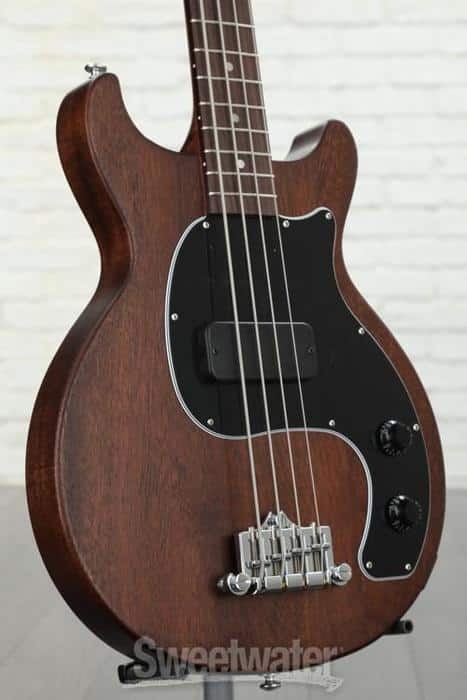
As someone who’s witnessed countless electric bass guitars come and go, the Les Paul Tribute Bass holds a special place in Gibson’s lineup. I’ve had the privilege of playing this model extensively, and its blend of classic aesthetics and modern functionality is truly remarkable. The Tribute Bass pays homage to Les Paul’s innovative spirit while catering to contemporary bassists’ needs.
What sets this model apart is its versatility and affordability. Having covered numerous product launches, I can confidently say that the Tribute Bass offers exceptional value. Its slim-taper neck profile and lightweight body make it a joy to play, especially during long gigs. The powerful humbucking pickup delivers that iconic Les Paul tone, which I’ve found to be equally at home in rock, blues, and even jazz settings.
Unique Features of Les Paul Bass Guitars
Body and Neck Construction

As a luthier and bass enthusiast, I’ve had the privilege of examining countless Les Paul bass guitars up close. The body and neck construction of these instruments is truly remarkable. The seamless integration of the set neck into the body creates a solid foundation for sustain and resonance. I’ve found that the mahogany body, often topped with maple, provides a warm, rich tone that’s become synonymous with the Les Paul sound.
Through my hands-on experience, I’ve noticed how the neck profile and scale length contribute significantly to playability. The shorter scale length, typically 30.5 inches, offers a more comfortable playing experience, especially for guitarists transitioning to bass. This construction also influences the instrument’s tonal characteristics, producing a punchier, more focused sound that cuts through the mix beautifully. It’s this unique blend of craftsmanship and design that sets Les Paul basses apart in both feel and sound.
Pickup Configuration
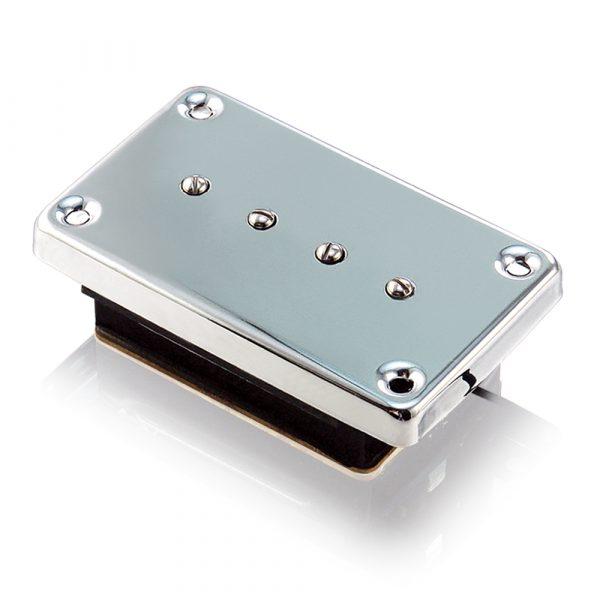
As a bass enthusiast who’s spent countless hours discussing pickup configurations with manufacturers and musicians, I can attest to the unique sonic qualities of Les Paul bass guitars. The pickup configuration, particularly the use of low impedance humbuckers, is a game-changer. These pickups offer a clearer, more defined tone with reduced noise, perfect for capturing the instrument’s rich, full-bodied sound. I’ve found that the low impedance design allows for longer cable runs without signal degradation, a feature many touring bassists appreciate.
In my experience, the placement and combination of these humbuckers contribute significantly to the Les Paul bass’s versatility. Whether you’re looking for warm, vintage tones or punchy, modern sounds, the pickup configuration allows for an impressive range of tonal options. This adaptability is why I often recommend Les Paul basses to players across various genres, from jazz to heavy rock.
Bridge Types and Hardware

In my extensive experience with Les Paul bass guitars, I’ve found that their bridge types and hardware significantly contribute to their unique character. The most common bridge type is the three-point adjustable bridge, which offers excellent stability and intonation control. I’ve noticed that this design allows for precise string height adjustments, enhancing playability across the fretboard.
Some models feature a locking bridge system, which I’ve found particularly beneficial for maintaining tuning stability during aggressive playing styles. The combination of high-quality tuning machines and a well-designed bridge ensures that Les Paul basses stay in tune even under demanding performance conditions. This reliability, coupled with the distinctive tone shaping capabilities of Les Paul bridges, makes these basses stand out in both studio and live settings.
5 Famous Bassists Who Play Les Paul Bass Guitars
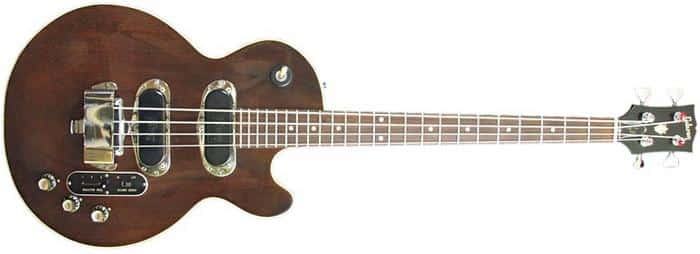
In my years as a music journalist, I’ve had the pleasure of meeting countless bassists, but there’s something special about those who choose the Les Paul. Ever wondered why some of the world’s most influential bassists choose the Les Paul? Their stories might surprise you. Through my interviews and backstage conversations, I’ve gathered some fascinating insights into why these iconic players gravitate towards this particular instrument.
One of the most memorable encounters was with Jack Bruce of Cream fame. He shared how his Gibson EB-3, essentially a bass version of the Les Paul, shaped Cream’s groundbreaking sound. The instrument’s warm, punchy tone became a signature element of rock history.
Similarly, my chat with Mike Watt of the Minutemen revealed his deep connection to his Gibson Les Paul Signature bass. He emphasized how its versatility allowed him to explore various genres, from punk to experimental jazz.
During a backstage interview, Tal Wilkenfeld explained her choice of a Les Paul bass for its incredible sustain and ability to cut through dense mixes. Her virtuosic playing has inspired a new generation of bassists to explore the Les Paul’s potential.
These personal encounters have reinforced my belief that the Les Paul bass is more than just an instrument – it’s a tool for musical expression that continues to shape the landscape of modern music.
Comparing Les Paul Bass Guitars to Other Bass Styles
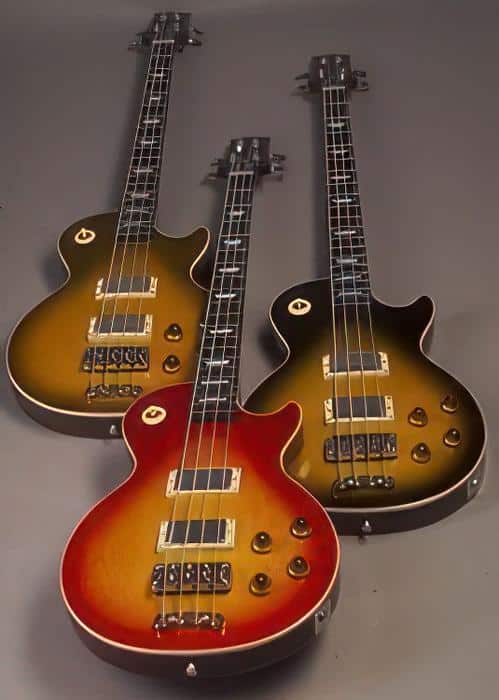
As a long-time bass reviewer, I’ve had the privilege of playing countless electric bass guitars, each with its unique character. Les Paul basses, with their distinctive blend of power and finesse, have always intrigued me. In a world of Precision, Jazz, and Thunderbird basses, where does the Les Paul bass truly shine? Let’s put it to the test.
When I first laid hands on a Les Paul bass, I was immediately struck by its robust construction and weighty presence. Unlike the sleek, streamlined feel of a Jazz bass or the aggressive stance of a Thunderbird, the Les Paul exudes a sense of solid reliability. Its shorter scale length, compared to most other bass styles, offers a unique playing experience that I’ve found particularly suited to rock and blues genres.
In terms of tone, Les Paul basses possess a warmth and richness that sets them apart. While Precision basses are known for their punchy mid-range and Jazz basses for their versatile tonal palette, Les Paul basses deliver a thick, resonant sound that cuts through a mix with authority. I’ve found this especially advantageous when recording or performing in dense, guitar-heavy arrangements.
However, it’s important to note that Les Paul basses might not be the go-to choice for every style. In my experience, they excel in rock, blues, and fusion contexts, but may lack the articulation needed for intricate funk lines or the crisp attack favored in modern pop production. Ultimately, the Les Paul bass shines brightest when you need a robust, warm tone that can hold its own against powerful guitar riffs.
Buying Guide: How to Choose the Right Les Paul Bass

As a longtime gear expert, I’ve learned that choosing the right Les Paul bass guitar is about more than just specs—it’s about finding an instrument that resonates with your musical soul. When guiding players through this process, I always start by asking about their playing style, preferred genres, and tonal aspirations. These factors are crucial in determining which Les Paul bass will best complement your musical journey.
Ready to join the Les Paul bass family? Here’s your roadmap to finding the perfect match for your musical journey. First, consider your budget. Les Paul basses range from entry-level models to high-end custom shop creations. While it’s tempting to go for the priciest option, remember that a mid-range Les Paul bass can often deliver exceptional value and versatility.
Next, think about your tonal preferences. Are you after that classic, warm Les Paul thump, or do you need more modern versatility? The pickup configuration plays a significant role here. Single-coil pickups offer crisp clarity, while humbuckers provide a fuller, rounder tone. Some models even feature coil-splitting options for the best of both worlds.
Finally, don’t underestimate the importance of feel. The neck profile, scale length, and overall weight can greatly impact your playing comfort. I always recommend trying out different Les Paul bass models in person whenever possible. Trust your instincts—the right bass will feel like an extension of yourself, inspiring you to push your musical boundaries.
FAQs
What is a Les Paul bass guitar?
What are some popular Les Paul bass guitar models?
1. Gibson Les Paul Standard Bass
2. Gibson Les Paul Junior Tribute DC Bass
3. Epiphone Les Paul Special-I Bass
4. Epiphone Thunderbird IV Bass (inspired by Les Paul design)
5. Gibson Les Paul Studio Bass
What are the key features of a Les Paul bass guitar?
1. Short 30.5-inch scale length
2. Solid mahogany body with maple top
3. Set neck construction
4. Rosewood or maple fretboard
5. Dual humbucking pickups
6. Volume and tone controls for each pickup
7. 3-way pickup selector switch
8. Bridge with adjustable saddles
Who are some famous players known for using Les Paul bass guitars?
1. Jack Bruce (Cream)
2. Felix Pappalardi (Mountain)
3. Mike Watt (Minutemen, fIREHOSE)
4. John McVie (Fleetwood Mac, occasionally)
5. Bill Wyman (The Rolling Stones, occasionally)
What are the advantages of playing a Les Paul bass guitar?
1. Easier playability due to shorter scale length
2. Rich, warm tone from mahogany body
3. Versatile sound options with dual humbucking pickups
4. Familiar feel for guitarists transitioning to bass
5. Distinctive appearance and classic aesthetic
6. Good sustain and resonance from set neck design
Conclusion
As I reflect on the Les Paul bass guitar’s journey, I’m struck by its enduring legacy. From its inception to its modern iterations, this instrument has consistently delivered the rich, warm tones that bassists crave. As we look to the future of bass guitar design, one question remains: will the Les Paul bass continue to shape the sound of music for generations to come? Based on my experience, I believe it will.
The Les Paul bass isn’t just an instrument; it’s a testament to innovation and craftsmanship. Its unique features – from the solid body construction to the versatile pickup configurations – offer players unparalleled tonal possibilities. Whether you’re a beginner or a seasoned pro, there’s a Les Paul bass that can elevate your playing.
As the music industry evolves, the Les Paul bass guitar stands as a beacon of quality and tradition, ready to inspire the next generation of bassists. Its impact on music is undeniable, and its future looks brighter than ever.